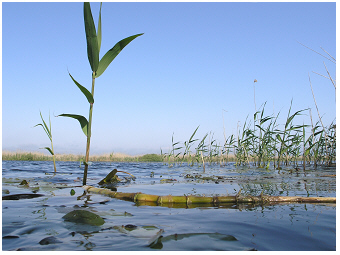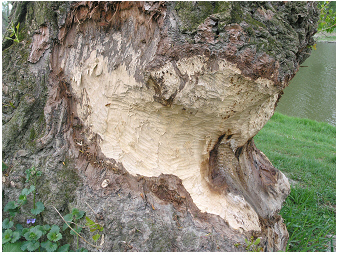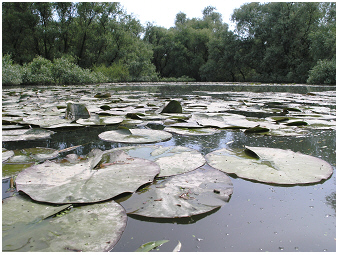About Danube: The river and its main tributaries connect many European countries
geographical location of the large river
 Danube delta, near Tulcea,
Romania, 2005:
Danube delta, near Tulcea,
Romania, 2005:
Meadows and woodland are surrounding the lakes in the delta.
 Danube floodplain, near Vienna, Austria,
2008:
Danube floodplain, near Vienna, Austria,
2008:
A sign that beavers (Castor fiber)
were recently at work here.
The second largest river in Europe, the Danube River, connects a large number of countries along its length: Germany, Austria, Slovakia, Hungary, Croatia, Serbia, Bulgaria, Moldavia, Ukraine and Romania. Other countries connected to the Danube tributaries are Bosnia and Herzegovina, Czech Republic, Slovenia, Montenegro, Switzerland, Italy, Poland, the Republic of Macedonia and Albania. The Danube River, with its tributaries and floodplain systems forms a vital landscape element across many national borders. The Danube River serves as a migration corridor for many plants and animals over long distances in the large Danube River Basin in Europe.
In particular in middle reaches of urban areas, the Danube River or side arms of the Danube River are often canals and, at least in the past, the water quality was further impaired due to high nutrient loads. An example is the side channel "Neue Donau" in Vienna, where the nutrient concentrations measured in year 1988 were much higher than compared with later five-year period from 1992 to 1996 (Dokulil and Teubner, 2000 R). The Neue Donau is located near the Alte Donau (sometimes also named "Old Danube"), a separate arm of the Danube River in the urban floodplain area of Vienna, which now serves as a recreational lake for the Viennese (ALTE DONAU / OLD DANUBE S). For more than two decades, the Alte Donau has undergone a lake restoration (Dokulil et al., 2018 R; Teubner et al., 2018 R; Teubner 2019 R) which shifted the oxbow lake from a nutrient-rich, algal turbid state to a water plant-dominated, clear-water state (Teubner et al., 2022 R) with sustained high water quality of high recreational value and providing many other ecosystem services for a higher quality of city life in Vienna, the capital of Austria (Teubner et al., 2020 R).
The International Associationof Danube research
(IAD) is the
scientific network about relating to Danube research founded in 1956 (see further about IAD-history, Haidvogl et al., 2023 R).
The elecetd IAD-presidium consists of a president, a vice president an a general secretary
are elected at an IAD-General Assembly for a 6-year voting period.
The mission statment of the newly elected general secretary in 2018, issues on the rapidely
changing
Danube River ecosystem over recent decades
(R).
The IAD bulletin Danube News
appears twice a year since 1999.
The member Country Representatives (IAD-CR)
and more than ten Expert Group Leaders who issue on water quality, habitat observation of
different biota, nature conservation and
sustainable development (IAD-EGL)
are building an active network covering the vast majority of Danubian countries joining the
IAD for many years. Among other activities as e.g having an observer role in the International Commission for the Protection of the Danube
River,
(ICPDR,
IAD organises every second year an international conference. The IAD-conference missions
reflect a still ongoing attempt to enhance our understanding for today's changing
environment in the Danube River or Danube River Basin
(IAD-conferences).
Studies on algae and other photosynthetic microbes in the Danube
River
have a long tradition in the history of IAD conferences since the 1950’s.
During recent IAD conferences, about 12-15% of Danube research presentations relate
to studies on microbial primary producers IAD conferences 2008-2023). These are photosynthetic
organisms
that either float freely and are carried along by the flowing water (phytoplankton)
or live attached to the river bottom (phytobenthos).
These studies describe in detail the abundance distribution of rare and common microbial
autotrophic organisms
across the Danube and its tributaries.
In addition, their interactions with prevailing environmental influences and with other
organisms within
the benthic and planktonic communities, as well as their use as bioindicators for
microhabitat reference conditions were investigated.
In recent years, the response of microbial primary producers to current environmental pollution
and eutrophication (excessive nutrient accumulation) and to global climate change,
biodiversity loss has been studied.
This shows that the current Danube has become a completely different habitat than a few
decades ago for microorganisms, but also for many other aquatic organisms: see e.g. the opinion letter "No doubt about it -
the Danube River Ecosystem is changing" by KT (2018), R.
There is, however, a growing awareness for nature protection and sustainable use of both the river and its floodplains
by people living along the Danube. The nexus between ecosystems and human activity is a central focus in recent Danube studies,
with particular attention given to "Ecosystem Services" and "Water-Energy-Food (security) Nexus" (example for the Danube Delta in Romania, see Balaican et al. in 2024).
cited References on this site for Danube River
Balaican D, Teubner K, Tudor I-M, Nichersu I, Burada A, Trifanov C, Tudor M, Iticescu C, Moraru L, Georgescu P-L (2024) Water Energy Food Nexus in urbanizing wetlands: Challenges and solutions explored through Choremes and Focus Maps. Water,16(7),922. DOI:10.3390/w16070922 OpenAcess
Haidvogl G, Bloesch J, Cyffka B, Hein T, Sandu C, Teubner K (2023) Research Cooperation in the Danube River Basin: The International Association for Danube Research (IAD). Der Donauraum, 63(3):65-73. FurtherLink
Teubner K, Teubner IE, Pall K, Tolotti M, Kabas W, Drexler S-S, Waidbacher H, Dokulil MT (2022) Macrophyte habitat architecture and benthic-pelagic coupling: Photic habitat demand to build up large P storage capacity and bio-surface by underwater vegetation. Frontiers in Environmental Science, 10:901924. DOI:10.3389/fenvs.2020.573724 OpenAccess /DataSheet_1-4: Lake_Depth_at_12%_Optimum_Light /DataSheet_2-4: Water_Transparency-Attenuation-Secchi_Depth /DataSheet_3-4: Sediment_P-release /DataSheet_4-4: Macrozoobenthos_Host_plants Supplementary-Material Data 1 to 4
Teubner K, Teubner I, Pall K, Kabas W, Tolotti M, Ofenböck T, Dokulil MT (2020) New Emphasis on Water Transparency as Socio-Ecological Indicator for Urban Water: Bridging Ecosystem Service Supply and Sustainable Ecosystem Health. Frontiers in Environmental Science,8:573724 DOI:10.3389/fenvs.2020.573724 OpenAccess
Teubner K (2019) The Alte Donau: Successful Restoration and Sustainable Management - An Ecosystem Case Study of a Shallow Urban Lake (eds Dokulil TM, Donabaum K, Teubner K; 2018). (book notes) Danube News 39:12–13 Look-Inside OpenAccess
Teubner K, Kabas W, Teubner IE (2018) Phytoplankton in Alte Donau: Response to trophic change from hypertrophic to mesotrophic over 22 years. In: Dokulil MT, Donabaum K, Teubner K (eds) The Alte Donau: Successful restoration and sustainable management - An ecosystem case study of a shallow urban lake. Aquatic Ecology Series, vol 10. Huisman J (ed), Springer:107–147 DOI:10.1007/978-3-319-93270-5_9 The final publication is available at Springer via DOI:10.1007/978-3-319-93270-5_9 Proof_Chapter_09 / FurtherLink_to_the_Book / Book_notes_in_Danube_News
Dokulil MT, Donabaum K, Teubner K (eds.) (2018) The Alte Donau: Successful restoration and sustainable management - An ecosystem case study of a shallow urban lake. Aquatic Ecology Series, vol 10. Huisman J (ed), Springer: pp 407 DOI:10.1007/978-3-319-93270-5 / Book_notes_in_Danube_News
Teubner K (2018) No doubt about it - the Danube River Ecosystem is changing. (Mission statement by IAD-general secretary) Danube News 38:2. Look-Inside FurtherLink
Barta V, Janauer GA, Teubner K (2010) Spatial patchiness and similarity of macrophyte assemblages along a cut-off channel of the River Danube in Linz (Austria). In: Proceedings 38th International Conference of IAD, Dresden 2010, Germany, 5 pages Look-Inside FurtherLink
Strausz V, Janauer GA, Teubner (2006) Predicted changes in macrophyte species composition induced by flooding in a Danube floodplain restoration area in Linz (Upper Austria). In: Proceedings 36th International Conference of IAD. Austrian Committee Danube Research / IAD, Vienna: 428-433. ISBN 13: 978-3-9500723-2-7 Look-Inside FurtherLink
Dokulil M, Teubner K (2000) Effects of reduced load in the river Danube on nutrients and phytoplankton dynamics in the flood-relief channel New Danube (Vienna, Austria). Arch Hydrobiol, Suppl Large Rivers, 12 (1):39–59 DOI:10.1127/lr/12/2000/39 Abstract Look-Inside FurtherLink
